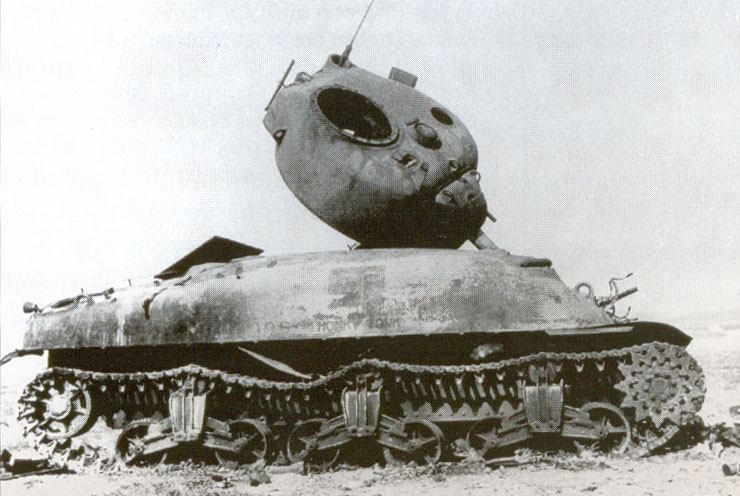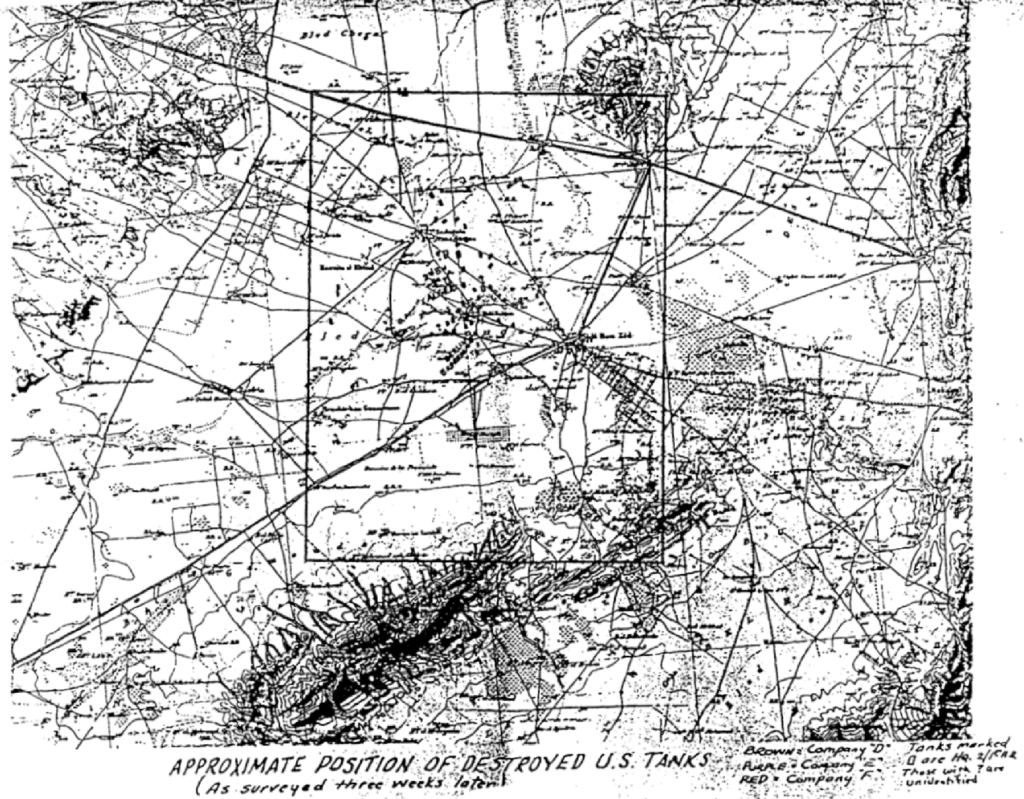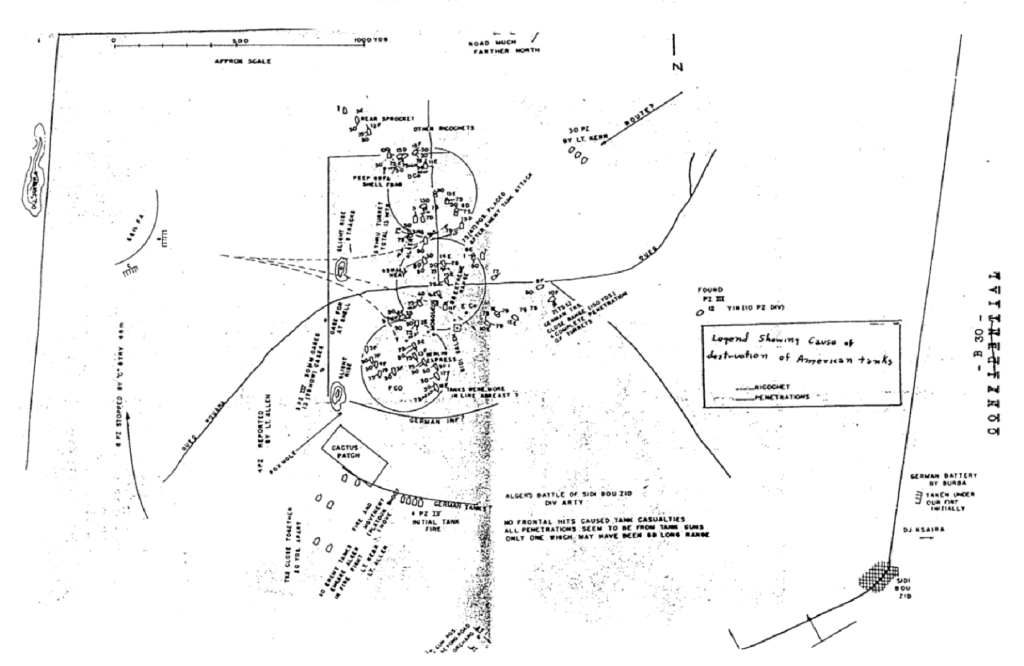
[NOTE: This piece was originally posted on 23 August 2016]
A few years ago, I came across a student battle analysis exercise prepared by the U.S. Army Combat Studies Institute on the Battle of Kasserine Pass in Tunisia in February 1943. At the time, I noted the diagram below (click for larger version), which showed the locations of U.S. tanks knocked out during a counterattack conducted by Combat Command C (CCC) of the U.S. 1st Armored Division against elements of the German 10th and 21st Panzer Divisions near the village of Sidi Bou Zid on 15 February 1943. Without reconnaissance and in the teeth of enemy air superiority, the inexperienced CCC attacked directly into a classic German tank ambush. CCC’s drive on Sidi Bou Zid was halted by a screen of German anti-tank guns, while elements of the two panzer divisions attacked the Americans on both flanks. By the time CCC withdrew several hours later, it had lost 46 of 52 M4 Sherman medium tanks, along with 15 officers and 298 men killed, captured, or missing.
 During a recent conversation with my colleague, Chris Lawrence, I recalled the diagram and became curious where it had originated. It identified the location of each destroyed tank, which company it belonged to, and what type of enemy weapon apparently destroyed it; significant battlefield features; and the general locations and movements of the enemy forces. What it revealed was significant. None of CCC’s M4 tanks were disabled or destroyed by a penetration of their frontal armor. Only one was hit by a German 88mm round from either the anti-tank guns or from the handful of available Panzer Mk. VI Tigers. All of the rest were hit with 50mm rounds from Panzer Mk. IIIs, which constituted most of the German force, or by 75mm rounds from Mk. IV’s. The Americans were not defeated by better German tanks. The M4 was superior to the Mk. III and equal to the Mk. IV; the dreaded 88mm anti-tank guns and Tiger tanks played little role in the destruction. The Americans had succumbed to superior German tactics and their own errors.
During a recent conversation with my colleague, Chris Lawrence, I recalled the diagram and became curious where it had originated. It identified the location of each destroyed tank, which company it belonged to, and what type of enemy weapon apparently destroyed it; significant battlefield features; and the general locations and movements of the enemy forces. What it revealed was significant. None of CCC’s M4 tanks were disabled or destroyed by a penetration of their frontal armor. Only one was hit by a German 88mm round from either the anti-tank guns or from the handful of available Panzer Mk. VI Tigers. All of the rest were hit with 50mm rounds from Panzer Mk. IIIs, which constituted most of the German force, or by 75mm rounds from Mk. IV’s. The Americans were not defeated by better German tanks. The M4 was superior to the Mk. III and equal to the Mk. IV; the dreaded 88mm anti-tank guns and Tiger tanks played little role in the destruction. The Americans had succumbed to superior German tactics and their own errors.
Counting dead tanks and analyzing their cause of death would have been an undertaking conducted by military operations researchers, at least in the early days of the profession. As Chris pointed out however, the Kasserine battle took place before the inception of operations research in the U.S. Army.
After a bit of digging online, I still have not been able to establish paternity of the diagram, but I think it was created as part of a battlefield survey conducted by the headquarters staff of either the U.S. 1st Armored Division, or one of its subordinate combat commands. The only reference I can find for it is as part of a historical report compiled by Brigadier General Paul Robinett, submitted to support the preparation of Northwest Africa: Seizing the Initiative in the West by George F. Howe, the U.S. Army Center of Military History’s (CMH) official history volume on U.S. Army operations in North Africa, published in 1956. Robinett was the commander of Combat Command B, U.S. 1st Armored Division during the Battle of Kasserine Pass, but did not participate in the engagement at Sidi Bou Zid. His report is excerpted in a set of readings (pp. 103-120) provided as background material for a Kasserine Pass staff ride prepared by CMH. (Curiously, the account of the 15 February engagement at Sidi Bou Zid in Northwest Africa [pp. 419-422] does not reference Robinett’s study.)
Robinett’s report appeared to include an annotated copy of a topographical map labeled “approximate location of destroyed U.S. tanks (as surveyed three weeks later).” This suggests that the battlefield was surveyed in late March 1943, after U.S. forces had defeated the Germans and regained control of the area.
 The report also included a version of the schematic diagram later reproduced by CMH. The notes on the map seem to indicate that the survey was the work of staff officers, perhaps at Robinett’s direction, possibly as part of an after-action report.
The report also included a version of the schematic diagram later reproduced by CMH. The notes on the map seem to indicate that the survey was the work of staff officers, perhaps at Robinett’s direction, possibly as part of an after-action report.
 If anyone knows more about the origins of this bit of battlefield archaeology, I would love to know more about it. As far as I know, this assessment was unique, at least in the U.S. Army in World War II.
If anyone knows more about the origins of this bit of battlefield archaeology, I would love to know more about it. As far as I know, this assessment was unique, at least in the U.S. Army in World War II.

The term superior is used very “leger” in military analysis and histography.
A weapon system isn’t superior just because of a few numbers, here it just means that it was better protected (though there is more to armour than just mm thickness, usually relative to its opponent, theres also a difference in armour effectivness and a basic value, WW2 Ballistics: Armour and Gunnery, Lorin Rexford Bird).
The Western Allies had Matildas IIa and Chars in the 1940 campaign, the Soviets T34s and KVs during Barbarossa and most of them were destroyed by so called “obsolete” or “inferior” tanks.
There is a big misconception about WW2 tank combat, still present today.
Tanks have strenghts and weaknesses (tradeoffs), their sights/superior optics,, superior steel quality, radio, cupola etc. can be better weapons than x amount of armour, especially if there is a weapons overmatch (and an unnecessary increase in weight). It is a choice (the respective nations economy will have a great impact on the AFVs design).
The M4 was not a bad tank at all, “tommy cookers” is just a ridiculous propagandistic myth, the Sherman was an overall better weapon system than the T-34 (Korea as the proof).
The Germans heavily invested in military personnel and their training, their high level of industrialization allowed them for sophisticated weapons (that is the important term).
E.g. (ancient times for a better “visualization”) The romans fought coordinated with gladius and scutum (at least after the reforms), while a Francisca Axe or Falcata might have more slashing power.
Furtheremore, the Germans had a significantly higher investment into human capital.
http://s451.photobucket.com/user/guaporense/media/Military%20outlays_zps46mi205v.png.html
of the total expenditures (outlayys, percentage of investment into a branche) a big fraction went to the personnel.
Interesting case study and comment. Tactics more than compensates for numbers, hardware and technical factors. Although I have never actually used the QJM, I have read about it with interest and I gained the impression (rightly or wrongly) that it is heavily weighted to scoring the relative weight of troops and equipment with some multipliers for commander ability. How does the QJM allow for tactical skill as demonstrated in this example?
This is some really good stuff. I will post an excerpt of it on my site with links back to the full article here. Thank you for posting this.
Thanks, and thanks for mentioning my Kursk book back last October.
“the Sherman was an overall better weapon system than the T-34 (Korea as the proof).”
This is what is known as failure to isolate the variables.